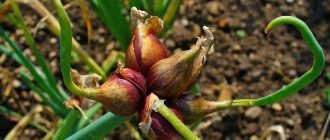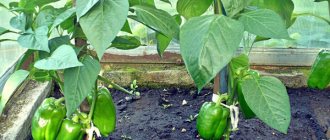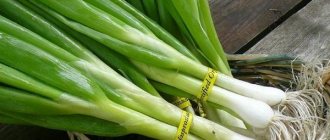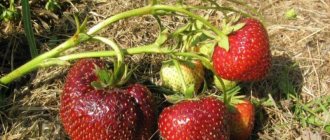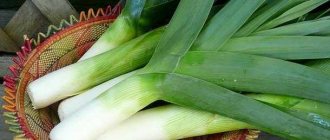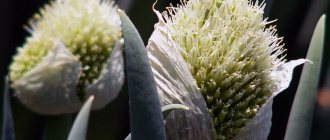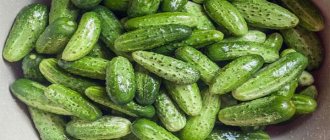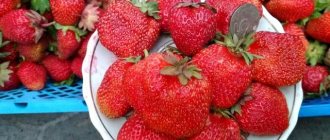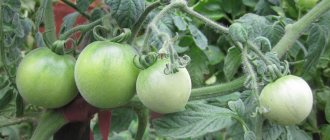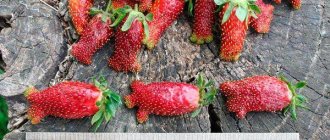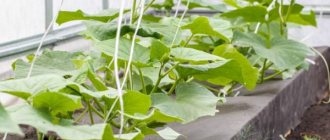Botanical description
Leaves are trifoliate, complex in shape. They are located on long stems, the height of which can reach 8-10 cm. Creeping shoots are characterized by the ability to take root. The root system is fibrous type, with a depth of 20-25 cm. The inflorescences are represented by a multi-flowered shield. The flowers are located on long peduncles extending from the root collar of the plant. The berries are complex, or prefabricated.
The characteristics and yield indicators depend on the varietal characteristics of strawberries. When choosing a variety, you should familiarize yourself with its description, characteristics and reviews of experienced gardeners. It is important to choose zoned varieties that will show the best results in home garden cultivation.
Growing in open ground
In order for a remontant strawberry plantation to always delight you with abundant fruits, it should be grown following special rules. This type of crop is most often propagated by seeds, and less often by tendrils. The seed method guarantees the production of varietal seedlings that are free from viruses and nematodes.
Seed selection and preparation
Seeds of remontant strawberry varieties can be purchased or collected yourself:
- even in the previous season, overripe, but not rotten berries are selected and the pulp is cut off from them;
- dry it in the sun or under a lamp and select the seeds.
See also: What are the benefits of strawberries for the human body?
Before planting, they are soaked and stratified. To do this, it is convenient to use transparent plastic containers with a lid and cotton pads:
- holes are made in the lid of the container to allow air to enter. The disks are moistened with water (growth stimulants Epin, Zircon or the like can be added to it), seeds are placed on one and covered with the other;
- close the containers and keep them in a warm place for two days.
After this, they are put in the refrigerator for one to two weeks for stratification. Make sure that the discs do not dry out and ventilate the container.
Sowing dates and patterns
In the Moscow region, the central zone of the country, the usual time for sowing seeds of remontant strawberry varieties is the last ten days of February, the beginning of March, in warmer regions - 2-3 weeks earlier.
The humidity of the seeding soil should be high - 70-80%. To do this, a kilogram of dry substrate from universal soil is diluted with 700-800 ml of water. Further work order:
- lay out the wet substrate in small containers;
- seeds are placed on its surface, lightly covered with a layer of dry substrate;
- spray a little with water;
- Cover with transparent film or glass.
After three true leaves appear, the seedlings are planted in separate cups. In April, they begin to harden the seedlings by taking them out onto the glassed-in veranda for several hours, then leaving them there overnight.
Since seedlings usually produce their first harvest next year, experienced gardeners prefer to plant remontant strawberry varieties in August or early autumn, adhering to the same work technology. Before the cold weather, the seedlings have time to become sufficiently strong.
Transplanting seedlings to a permanent place
In the middle zone, spring planting of remontant seedlings in open beds is approximately carried out in May. In other regions, adjustments are made to the timing based on the climate.
The beds are prepared in advance by loosening and adding compost. Close to neutral, medium loamy fertile soils are considered the best. According to the chosen pattern, holes are dug 10-20 cm deep. The root collar of the bush should be slightly above the surface of the earth or at the same level with it.
Nesting method
In general, the planting method is chosen depending on the characteristics of the variety, the free area for beds and the number of plants.
The nesting method is good for remontant varieties that throw out mustaches. The distance between plants is maintained at least half a meter. Plants do not contact each other, do not shade each other, and do not infect each other when diseases occur.
A relative disadvantage is the inefficient use of land, but such planting ensures high crop yields, which completely covers its disadvantages.
Carpet
This is a more space-efficient method that allows you to plant bushes at a distance of 20 cm in rows and between rows. It is used for varieties with compact plants, but for productive remontant species it is rarely used.
Private
With this method, 20-25 cm are maintained between the bushes, and 70 cm between the rows. It is good directly for remontant strawberries and is convenient for caring for them.
Using the row method, you can plant strawberries in several rows - from one to five in a ribbon.
Strawberries: choosing a variety (video)
KDS strawberries are represented by early, mid-early, mid-ripening, and late varieties, among which there are very promising ones for cultivation in many regions of our country.
| Variety name | Maturation period | Description of the plant | Characteristics of the berry | Peculiarities |
| "Honey" | Ultra early | Erect and dense, has a strong root system | Large, conical, dark red, glossy, weighing up to 50 g | The variety was bred by American breeders and combines high yield with excellent taste of berries. |
| "Kimberly" | Early | Low, squat, quite powerful and strong | Large, conical, dark red, glossy, weighing up to 50 g, with a slight caramel flavor and pleasant aroma | From Dutch breeders. Highly marketable |
| "Crown" | Mid-early | Small, with medium foliage, open, with powerful peduncles | Medium to large size, dark red color with a slight sheen | Dutch is a very productive and unpretentious variety. Good frost resistance |
| "Elsanta" | Average | Quite a large bush with large leaves | Medium or large size, dense consistency, dessert taste, regular shape | One of the sweetest varieties bred in the Netherlands |
| "Bohemia" | Mid-late | Powerful, erect, with large leaves and compact inflorescences | Large, conical, neckless, dark red, glossy, weighing up to 24 g | Received by VSTISP specialists and is considered universal |
| "Adria" | Late | Medium vigor, well developed, with dark green foliage | Large, very juicy and aromatic, weighing up to 42 g | A popular and sustainable Italian variety with excellent quality characteristics and high yields |
| "Malvina" | Very late | Vigorous, strong, with dark green glossy leaves | Large sizes, bright cherry color, weighing up to 40-45 g | German variety with high transportability rates |
Miracle of the World
The variety is amazing, its berries are very aromatic, with a honey taste, complemented by sourness. Thanks to continuous fruiting, they ripen throughout the summer; the harvest can be roughly divided into 7-10 waves.
The first berries are harvested at the end of May-beginning of June; the perennial bears fruit all summer and autumn. As a rule, about 1.5-2 kg of berries are collected from each Miracle of the World bush.
A powerful plant with many shoots and excellent productivity multiplies quickly. Unlike other varieties of NSD, its ovary is formed not after 1.5 months, but in parallel with the ripening of the berries that have just begun to turn pink.
They can vary: from a regular cone to an “accordion” and an oblong shape with a narrow spout. The bush surprises with fruits of different “calibers” located on one bush. Its height reaches 16-18 cm. Garden strawberries of this variety are characterized by frost and drought resistance, they tolerate shading and do not fade in the heat. Has stable immunity and is not susceptible to diseases.
More on the topic: Remontant strawberries Queen Elizabeth 2
The best large-fruited varieties
A feature of the best large-fruited varieties of strawberries is the formation of berries that are several times larger in size than the fruits of standard varieties, while the taste qualities of garden strawberries are at a high level. The highest yield of such plants is observed in the second year after planting.
| Variety name | Maturation period | Description of the plant | Characteristics of the berry | Peculiarities |
| "Chamora Turussi" | Late ripening | Very powerful plants and developed peduncles | Large, with excellent taste | Generates high yields even on poor soils |
| "Comrade winner" | Mid-season | Tall, densely leafy, with dark green leaves, peduncles higher than leaves | Dark red color with gloss, with high sugar content | German variety with high yield and excellent quality indicators |
| "Humi Grande" | Mid-season | Quite powerful, with large leaves | Intensely colored, sweet, with juicy and aromatic pulp | A stable German variety with strawberry berry aroma |
| "Golden" | Mid-season | Large bushes with large horns and a powerful root system | Large in size, pinkish-red, fragrant, weighing up to 100 g | The variety can be cultivated in one place for at least eight years |
| "Primella" | Mid-season | Powerful and highly branched, with a very developed root system | Very large, sweet, aromatic, with a pronounced pineapple flavor | Dutch popular variety with high yield and extended ripening period |
Diseases and pests of strawberries, combating them
Since strawberries love high humidity, they are often affected by fungi that actively develop in a humid environment. The most common diseases include powdery mildew, gray mold, late blight (these types of diseases are especially dangerous when buds or berries appear):
- A dirty gray coating on the leaves and stems leads to the death of the green parts of the plant, and then to its death. Therefore, to prevent powdery mildew, it is necessary to spray the bushes with a solution prepared from 20 grams of soap and copper sulfate per bucket of water. Drugs like Topaz will also help.
- Gray rot affects berries, which become moldy, deformed, and lose their taste. Because of the disease, the entire berry crop sometimes dies. Bordeaux mixture can prevent illness.
- If the leaves begin to fade, acquiring a grayish tint, then this is a late blight fungus infection, which often destroys the entire berry plantation within a few years. Salvation is only in pre-treatment of the plant roots with Agat.
The most common pests of strawberry plantings are:
- The strawberry mite is difficult to see, but it causes a lot of damage to the leaves. They shrink and die. The destruction of the pest must take place quickly, otherwise it will infest the entire strawberry plantation. Spraying with a solution of colloidal sulfur twice during the summer will save the crop.
- The weevil beetle actively gnaws on the foliage, and the larvae chew on the buds. Spraying with Decis, Iskra will defeat the parasite.
- Millipedes, slugs, and snails love to feast on the plant and its fruits. They are effectively combated with a metaldehyde preparation, which is scattered over the beds.
- It is difficult to get rid of spider mites that have taken a liking to tasty bushes. An effective way to combat it is to treat it with karbofos (3 tablespoons per bucket of water). The procedure is carried out by sprinkling after picking the berries. For better effect of the planting product after treatment, it is better to cover it with film for three hours. Mowing leaves after August 10 and then burning them will also save you from the pest.
Caring for berry bushes throughout the summer will result in a delicious treat for the whole family.
The best remontant varieties of NSD
You can achieve high yields per hundred square meters of berry plantings by growing remontant strawberries with neutral daylight hours (NDD). The best remontant varieties of strawberries differ from traditional varieties not only in their large fruits, but also in their high yields, as well as the transportability of the harvest.
| Variety name | Ripening time | Description of the plant | Characteristics of the berry | Peculiarities |
| "San Andreas" | Medium aging | Powerful berry bushes with average yield rates | Large sizes, glossy, with harmonious taste, average weight up to 30 g | From American breeders. Has a high level of yield of marketable berries in the first wave of fruiting |
| "Bourbon" | Ultra early | Tall, medium leafy, with straight growing peduncles | Large in size, regular elongated conical shape, bright red, glossy, with a pleasant and harmonious taste | The variety from French breeders is distinguished by its constant fruiting |
| "Linosa" | Early | Medium vigor, with medium dense leaves | Light red, with very bright and uniform surface coloring | Italian industrial variety, adapted for cultivation in our country |
| "Capri" | Precocious | Average growth vigor, with average density indicators | They have the correct conical shape, large sizes, and are visually attractive | A variety from Italian breeders, characterized by continuous fruiting, winter-hardy and disease-resistant |
| "Monterey" | Early ripening | Well developed, with numerous peduncles | Cone-shaped, with juicy and sweet pulp | Bred in California, has good productivity |
Rules of care
Plants of most strawberry remontant varieties age quickly. As a rule, they produce the largest harvest only in the first year of life. In general, varieties with long daylight hours live 2-3 years, independent ones - less. Correct agricultural technology allows you to obtain the maximum possible yield during this time, which greatly exceeds the volume of fruit from conventional varieties.
Watering
The bark system of strawberry bushes is superficial; it cannot take moisture deep from the soil, but intensively evaporates it from the leaves. And remontant varieties especially need watering, since their fruiting is more intense:
- the first few days after planting, seedlings are watered daily in the morning or evening, then every 2-4 days;
- Last year's bushes begin to be watered at the end of April, if there is little moisture, and in the summer, with the beginning of intensive formation of berries, at least every week or two, making sure that the soil under the plants is moist to a depth of 2-3 cm (especially in August and September).
Mulching the beds with straw, or better yet, black agrofibre, is convenient not only for harvesting, but will also reduce the number of waterings.
Foliar and root feeding
Proper fertilization of remontant varieties allows you to extend their life and produce high yields. They need to be constantly fed with nitrogen and potassium (NSD varieties - more than others). If phosphorus was initially added to the soil in sufficient quantities before planting, it is no longer necessary to add it during the season. It is useful to mulch the beds with humus at the rate of 2-3 kg per square meter.
At the end of spring, remontant varieties are fertilized with a 1-2% urea solution. After the first fruiting and at the beginning of the second flowering at the end of June-July, it is useful to feed them with a solution of chicken droppings and manure.
In total, at least 10 complex feedings must be carried out during the season. It is important to continue fertilizing remontant strawberries until late autumn. Its roots vegetate for a long time; the plants cannot be allowed to go into winter weakened. Both organic and mineral fertilizers are good as fertilizers.
Mustache trimming
Whiskers growth is most active in July-August. The onset of cold weather slows down and completely restrains their growth. The growth of mustaches cannot be ignored, as they can greatly thicken the rows. They are pruned during the entire growing season, but if there is a goal to obtain planting material in this way, then the spring-summer mustache is added dropwise to obtain ready-made seedlings in August.
In the fall, mustaches should be trimmed, and dried or blackened mustaches should be destroyed.
Mulching and loosening the soil
Mulch - sawdust, straw, or better yet, special non-woven fiber - helps retain moisture in the soil and prevents weeds from growing. This reduces labor costs for caring for strawberries, and in addition, preserves the berries from rotting, preventing them from lying on the ground. Mulch material is used to cover the soil when planting seedlings.
Loosening provides more oxygen to the roots. It is carried out several times before the fruits begin to ripen, and after it begins, they try not to disturb the plants. But if the ground is mulched, you won’t have to do any loosening at all.
See also: When and how to prune strawberries correctly
Pest and disease control
Strawberries of remontant varieties, especially the beardless ones, are more resistant to diseases compared to ordinary ones. Nevertheless, although to a lesser extent, it is threatened by the usual cultural problems:
- gray rot is a fungal disease that severely affects crops in cool and damp conditions. Spots appear on the berries, quickly becoming covered with a fluffy coating. Diseased fruits are immediately destroyed, and the remaining bushes are treated with copper oxychloride after harvesting;
- Powdery mildew affects leaves, which eventually curl and turn brown. The affected plants are destroyed, and treatment with a weak solution of potassium permanganate will help save the remaining ones;
- brown spot - causes leaf blades to turn brown and fall off. In the spring or after harvesting, plants are sprayed with copper chloride.
Of the pests, the most dangerous to the crop is the strawberry mite - a transparent and inconspicuous insect. Bushes affected by it turn yellow, dry out, and stop developing. To destroy the mite, the plantation must be treated with karbofos immediately after harvesting.
Aphids love to attack young seedlings. A solution of wood ash and laundry soap will help. It is harmless and can be used at any time.
How to preserve strawberry bushes in winter
The need to cover strawberries for the winter depends on the climate of a particular area, the composition of the soil, and the characteristics of the variety. It is advisable that zoned frost-resistant varieties be selected for regions with cold climates. For a good wintering of remontant strawberries:
- remove diseased leaves from plants, trim the mustache;
- weed the bed if necessary;
- fertilize with wood ash;
- cover the beds with suitable material - spruce branches, sawdust, leaf litter.
Strawberries prepared in this way tolerate both frost and thaw well.
Replanting remontant strawberries
It is believed that remontant varieties need to be replanted once every 2 years, since plants with intense fruiting quickly deplete the soil. In reality, specific conditions must be taken into account.
For transplantation, select developed, healthy plants that have at least five leaves. The transplantation technology is similar to conventional types:
- the day before the procedure, the plants are watered;
- carefully dig out, place in a clay mash for 2-3 hours;
- planted in a new place.
Typically, replanting strawberries is carried out in the fall, so that in the time remaining before frost (20 days) the bushes have time to take root and get stronger. At the same time, you need to plant the rooted mustache. The root system of the plants will develop over the winter and in the spring the remontant strawberries will quickly produce a harvest.
Spring replanting is rarely carried out, since it precludes obtaining a quick harvest. Remontant varieties will begin to produce harvests no earlier than mid-summer. In any case, in order to properly replant the plant in the spring, it is advisable to do it early, before the flower stalks appear. If they are already there, they are removed during transplantation so that the bush does not waste energy maintaining them.
Secrets of increasing productivity
To increase the quality and quantity of the berry crop harvest, it should be remembered that strawberries form the strongest and most productive tendrils in the first year of fruiting. Experienced gardeners share their secrets of growing strawberries, which can significantly increase the yield of the berry crop:
- day-neutral berry crop plants should be replaced annually, and long-day garden strawberries can be grown without loss of yield for three years;
- high productivity of the crop requires cultivation on fertile soils, high-quality fertilizers;
- productive varieties must be grown exclusively on flat and well-lit areas, free from any weeds;
- high-quality fertilizing and watering must be supplemented by regular loosening of the soil and removal of excess tendrils, which can reduce the quantity and quality of the harvest;
- despite high rates of resistance to major diseases and plant parasites, strawberry plantings require timely preventive treatments;
- Harvesting should be regular; the berries should not be allowed to overripe, as in this case there is an overconsumption of nutrients.
Trimming
It is recommended to prune the bushes in autumn and spring, when the cultivation and care of remontant strawberries is completed. When the autumn harvest is completed, the leaves are carefully removed and all tendrils are pinched off. The main thing is not to disturb the sinuses of the upper leaves - they bear fruit buds over the winter. Only mature healthy shoots are suitable for wintering. After autumn pruning, the area is treated to prevent the appearance of pests, and plant disease is prevented. In the spring, pruning is aimed at removing overwintered, withered leaves when the procedure was not completed in the fall. The area is treated for pests and diseases. Cleaning leaves is necessary to eliminate the likelihood of developing diseases and transmitting pests. Many gardeners prefer to carry out hygiene procedures for plants in the spring.
